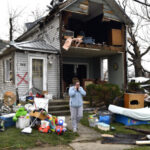The government could end up repeating mistakes seen after Hurricane Katrina without a better plan for housing people after a catastrophe, the Homeland Security Department’s internal watchdog told lawmakers this week.
Richard Skinner, DHS’s inspector general, said at a House Homeland Security hearing that the agency still relies too heavily on temporary mobile homes, and it doesn’t have a coordinated plan for more quickly getting people into permanent housing.
Craig Fugate, who became the Federal Emergency Management Agency director in May, acknowledged that the agency’s system is flawed but said it is designed by law to be a temporary “bridge” to a more permanent solution. He said FEMA needs help from Congress and state legislatures to fix the problems.
“It’s not a long-term solution,” he said of using trailers and mobile homes as a last resort after widespread displacement. “Our business is sheltering … we do not have the solution for how we re-establish housing stock.”
Skinner said FEMA’s trailers and mobile homes are fine for routine disasters but inadequate to handle the kind of widespread destruction seen after rare catastrophes such as back-to-back hurricanes Katrina and Rita in 2005. Not only does temporary housing leave communities unsettled — thousands of families have been living in limbo along the Gulf Coast for several years — but it is wasteful, he said.
FEMA, for example, sometimes spent more than $100,000 after Katrina to keep a family in a temporary trailer for 18 months and has paid rent for thousands of families for more than three years. But it is restricted from spending significant amounts to repair permanent housing.
Skinner said FEMA is hamstrung by federal laws limiting its role in the broader rebuilding effort. He recommended that FEMA be given more leeway in facilitating permanent housing and that the Housing and Urban Development Department take over responsibility for housing assistance at some point after FEMA’s initial response.
“FEMA needs better alternatives that quickly restore housing stocks,” Skinner said.
Nearly four years after hurricanes Katrina and Rita, about 3,000 households remain in federally supplied trailers and mobile homes in Louisiana and Mississippi. That’s down from a high of 143,000 along the Gulf Coast after the storms.
Some of the trailers were found to have high levels of formaldehyde, a toxic chemical, and are being scrapped after residents complained of feeling sick after living in them.
The Obama administration recently offered to sell other trailers and mobile homes to hurricane victims for $5 or less.
___
On the Net:
FEMA: http://tinyurl.com/l6ytvq
Was this article valuable?
Here are more articles you may enjoy.

 Jury Awards $80M to 3 Former Zurich NA Employees for Wrongful Termination
Jury Awards $80M to 3 Former Zurich NA Employees for Wrongful Termination  Harvard Study Again Stirs the Pot on Demotech Ratings of Florida Carriers
Harvard Study Again Stirs the Pot on Demotech Ratings of Florida Carriers  4,800 Claims Handled by Unlicensed Adjusters in Florida After Irma, Lawsuit Says
4,800 Claims Handled by Unlicensed Adjusters in Florida After Irma, Lawsuit Says  Gallagher: Global Insured Natural Disaster Claims Again Dominated by Severe U.S. Storms
Gallagher: Global Insured Natural Disaster Claims Again Dominated by Severe U.S. Storms 